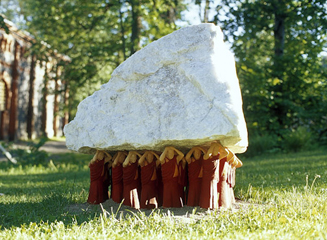- CA2M MUSEUM
- exhibitions
- OTTO KARVONEN
OTTO KARVONEN

At the start of the 19th century, Charles Waterton manufactured the first nest box ever. This eccentric British naturalist was one of history’s first conservationists. Among his many contributions is an essay describing his trip to South America which would go on to inspire other biologists, such as Darwin, and the fact of having created one of the first known nature reserves on building an immense wall of roughly 5 kilometers around his Yorkshire estate, in England. His interest in doing so was to protect a space in which wildlife could continue without the interference of undesirable human interventions, thus preserving an original habitat.
Since then, many others have built nest boxes as a pastime. In the same way, the designation of protected areas has also become more widespread. Yet, this has all occurred at a far slower pace than the destruction of those natural habitats by devastating societies. The impact of this annihilation on both natural and human life is so vast as to be difficult to quantify, although what is clear is that it has had tremendous effects on the lives of people and contemporary demographic movements.
Almost two centuries later, Otto Karvonen (Helsinki, 1975) also built nest boxes as part of his project, Alien Palace Birdhouse Collection, a series of birdhouses that he has gradually installed in various places all over Europe. His objective remains the same as Waterton had in mind two hundred years ago: to offer birds a safe and comfortable haven in which to raise their chicks, enjoying their presence. A nest box only makes sense if it is occupied at the right moment by the birds for which it was designed and it is essential to get the design right. The diameter of the orifice will determine the type of bird willing to nest there. A difference of just a few millimeters gives rise to very different results, and will dictate whether it is the Eurasian blue tit or the European Pied Flycatcher, to mention two typical species of the Madrid mountains, that takes refuge there. Madrid, like the entire Iberian Peninsula, is a regular stop on the journey made by migratory species, which twice a year cross from North to South in Autumn and South to North in Springtime, in their constant transit between Africa and Europe. Some nest boxes aim to convince these birds to stay, offering them a comfortable place to persuade them to refrain from continuing their constant migration.
Otto Karvonen takes all of these factors into consideration when designing his boxes, for which he follows a very precise contemporary architecture model, like that of foreigner internment centers. The way these work is, in a certain way, the opposite of how the nest boxes work. The Foreigner Internment Centers are non-penitentiary establishments in which certain people are held, such as citizens from non-Community countries without the necessary documentation, while their legal situation is being resolved or proceedings for their expulsion from the country are set in motion. Only some of the interned have committed a crime, as those who really have broken the law are probably being held in real prisons. This is an architecture style that is repeated across the twentysix member countries of the Schengen zone, with very few variations and the characteristics of which are reminiscent of prisons, although their design often presents a friendlier appearance. In Spain, there are eight establishments of this type, ever more subject to public debate.
Two of his «palaces» are exhibited on the CA2M terrace, inspired by the Metsälä Centre, in Helsinki, and that of Aluche, in Madrid. His intervention has been meticulously considered, yet is voluntarily modest. This is generally what happens in his work: specific projects, which arise from a delicate research into the context they are presented in. His works propose a dislocation of the everyday routines, a short-circuit between our expectations and reality. They surprise. Sometimes, through the alteration of traffic signs to warn of the risks of climate change (Signs for climate change, 2009). Others, demonstrating how not everything unknown is necessarily dangerous, by writing a friendly phrase in all sorts of non Latin alphabets that have a bothersome appearance (Alert, 2011). Thus, he puts forward some matters that aim to generate new views of the cultural and social context we are surrounded by, as well as the decisions which, as a community, we make to solve the crises, whether big or small, that we
face.
Otto Karvonen’s intervention is inserted on the CA2M terrace, which already had a series of other nest boxes that form part of its small urban garden, a place in which to reflect on ecology and society. Likewise, he adds another element to the reflection proposed by the Centre on conflicts, their ever difficult comprehension and representation. The presentation of his work in the CA2M is framed within Focus Finland, the ARCO art fair program dedicated to this Scandinavian country.
In collaboration with
![]()
![]()